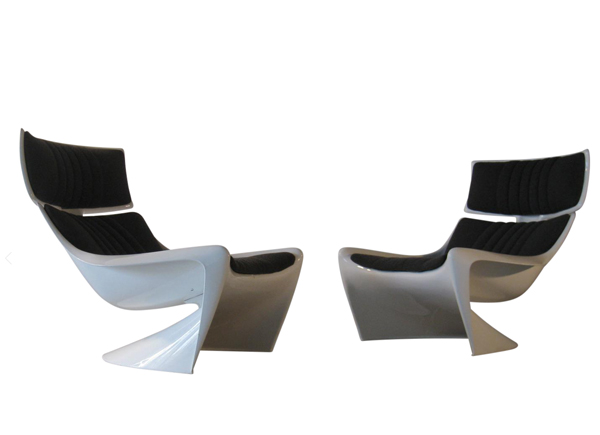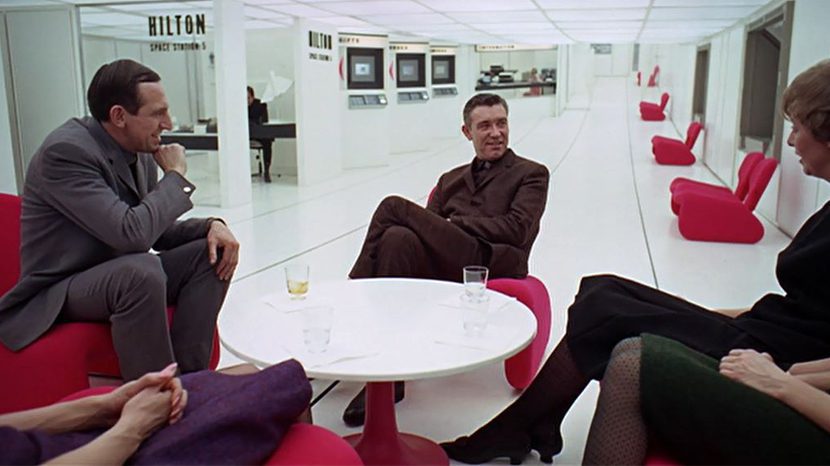Outstanding spaceship interiors in film (chosen by design and film experts) to mark the moon landing anniversary
July 20, 2019 is the 50th anniversary of humans first landing on the Moon as part of NASA’s Apollo 11 lunar mission. To mark this monumental achievement we asked renowned film and design experts (as well as an astronaut!) to share with us their favourite space station and spaceship interiors in film and TV.
Thanks to a multitude of ground-breaking era-defining films including Things to Come, 2001: A Space Odyssey, Star Trek and Gravity, the concept of space travel and spacecraft design has fired our imaginations. As far back as 1902’s Le Voyage dans la Lune (A Trip to the Moon) where a group of astronomers travel to the moon in a cannon-propelled capsule and from the Space Race era of the 1960s, film has played a pivotal part in our collective view of what ‘the future’ looks like. ‘Science Fiction’ time and again evolves into ‘Science Fact’.
So, what do our panel think are the most inspiring and influential spaceship interiors in film?
Michael and Denise Okuda:
The Starship Enterprise in Star Trek

“In designing the Starship Enterprise bridge for the original Star Trek, art director Walter M. “Matt” Jefferies had not only to envision a futuristic command center, but he had to construct it on a tiny budget, and on a very tight schedule. Jefferies merged his aesthetic sense with something he called “aircraft logic,” meaning that he used his background as an aviator to imbue his creation with a sense of functionality, even though he had no real idea how “warp drive” would work.
“Yet his tight budget meant he couldn’t afford realistic 1960s-style switches and instruments. Despite – or because of – these constraints, Matt devised a clean, sleek, brilliantly minimalistic style. His Enterprise bridge not only served as a stylish backdrop to Captain Kirk’s adventures, but it remains an icon of futuristic design, studied by real-world agencies including the US Navy, Air Force, DARPA, and NASA.”



In celebration of the 50th anniversary of Star Trek, a fully authorised revision of the popular reference companion: a two-volume encyclopedia featuring a completely new design, stunning new full-colour photographs and illustrations, and 300 pages of new entries, packaged in a specially designed and shrink-wrapped deluxe slipcase.

Star Trek Encyclopedia
Sir Christopher Frayling:
The space age interiors of Everytown in Things to Come (1936)

“The cool, see-through furniture for the scientific elite, living in high-rise nuclear-powered underground dwellings in Things to Come‘s Everytown 2036, looks glass – like designer Oliver Hill’s futuristic bedroom for the then-recent ‘British Art in Industry’ exhibition at Burlington House – but was in fact made of a trendy display plastic called Rhodoid.
“Reviewing the film for ‘The Listener’ magazine, Alistair Cooke spotting this connection, questioned whether today’s avant-garde ideas could possibly still be around in a hundred years time, but added nevertheless that “when it comes to considering what sort of room we shall be living in [in 2036] – mine’s in oak, just six feet by three – your guess is as good as mine. But it could hardly be as good as [the film’s production designer] Vincent Korda’s.”
The interior of the large shell lowered into the space-gun to the moon, at the climax – always filmed from above – is like a shiny metal submarine, with exposed engineering and criss-crossed tubes, two white rope-ladders and comfortable seats for the two astronauts and above them a clock (school of Fritz Lang’s ‘Woman in the Moon’). The only advice to the brave couple, at the last minute, is “contract all your muscles when the concussion comes”. Excellent advice. They would, in fact, have been reduced by the concussion to a pile of strawberry jam soiling that pristine floor.”

David Sheldon-Hicks: The spaceship interior of Flight of The Navigator (1986)

“Growing up in the 80’s, I feel good sci-fi is a big part of my cultural reference, and I’m a massive fan of the film Flight of the Navigator. What I loved about the interior of the spaceship was the total adaptive geometry of reflective surfaces that unfold and move to create dynamic furniture structures.
“The intelligent and adaptable furniture, forming out of walls and floors to fit the user, continues to be such an exciting idea to me and feels more relevant now than ever, inspiring ideas about dynamic spaces, smart buildings and smart cities.”

The futuristic, elegant stainless steel cutlery designed by Jacobsen used by the Jupiter Mission crew to eat dinner In Kubrick’s 2001: A Space Odyssey (1968). Approx £146.67 Inclusive of VAT (eg UK) if applicable / $230


Arne Jacobsen cutlery as seen in 2001: A Space Odyssey
Designer: Arne Jacobsen
Georg Jensen
Director: Stanley Kubrick
John Beard:
Things to Come (1936)

Production Designer John Beard was responsible for the design of the movie Thunderbirds (2004): “Although not commercially successful, I liked the challenge of trying to update the original Thunderbirds for the VSFX generation. For that I looked at the redesign of the Mini and the Fiat 500 which were new at the time and tried to take a retro-futuristic direction to the spaceships” he says.
His choice of favourite film for space age design is also the ever-influential 1936 film Things to Come “because not only was it my first view of amazing sci-fi as a young boy in the 50s but because it’s modernism also started my curiosity about the future of design in the world. Even more remarkable was that their vision, unlike available images for today’s designers, was based on nothing that had been done before. (Dan Dare was equally influential but sadly nobody had made a good film version yet!)” says Beard.

We are proud to present the Djinn chair, Djinn stool and Djinn sofa – as seen in the sci-fi masterpiece 2001: A Space Odyssey, one of the most iconic chair designs ever to be featured in a film. Approx £904.17 – £3,958.33 / $1421


Djinn chair, Djinn stool, Djinn 2 seat sofa by Olivier Mourgue as seen in 2001: A Space Odyssey
Designer: Olivier Mourgue
Airborne
Director: Stanley Kubrick
Sanja Ostergaard:
Star Trek II, The Wrath of Khan (1982)

“My choice may not be a spaceship exactly, but a movie with a starship at it’s heart is Star Trek and I choose the Star Trek II, The Wrath of Khan (1982) for quite personal reasons: It features the President Lounge Chair, 265 designed by the king of space age design – my Danish father Steen Ostergaard – in Captain Kirk’s apartment. It appears that Captain Kirk was collecting some classic vintage furniture for his 23rd Century San Francicso abode! [Scifi Stackexchange tells us that “James T. Kirk’s San Francisco apartment was the home of Admiral James T. Kirk in 2285. It was in a tall skyscraper in San Francisco and featured sweeping views of the city, the bay, Alcatraz, the Golden Gate Bridge and at least two other prominent 23rd century skyscrapers.”]

“The President Lounge Chair, 265 was designed in 1968 as part of the A-Line collection for CADO and was originally produced in six colours: red, white, blue, green, brown and beige (and the upholstery in many more colours) and can be used indoors as well as outdoors. At the time of its original production is was cast in the biggest injection mold in the world.

“Star Trek isn’t the President Lounge Chair’s only space connection – it was also used in the rocket base in Houston Texas where it was specially moulded to the floor so that they wouldn’t move when rockets were being launched! This chair has gone on to be featured in many books, magazines and movies.
Steen Ostergaard furniture has also been featured in other films such as the 291 Chair in the Bond film The Spy Who Loved Me and the the 290 chair in The Fifth Estate and A Hologram for the King.
Dave Addey:
2001 A Space Odyssey‘s (1968) Space Station 5 and Aries interiors

“Kubrick’s design team adapted prototypes from 40 real-world companies for 2001: A Space Odyssey’s spacecraft interiors, including a Whirlpool space kitchen that dispenses liquid meals, and a Zero Gravity Toilet whose ten-step instructions are essential reading before use. This isn’t just product placement, however – Whirlpool provided personal hygiene systems for NASA’s Gemini and Apollo missions, so they knew a thing or two about in-flight conveniences even before Apollo 11 put a man on the Moon.
“Indeed, it’s impressive to see how many of 2001’s fixtures and fittings don’t feel futuristic to present-day viewers. When Dr Floyd watches an in-flight movie on a flat-screen seat-back display, it’s easy to forget that such a device didn’t exist until 1988. And when he makes a video call home to Earth, we’re reminded that Bell Labs made video calling a reality in 1964, decades before FaceTime and Skype.”



In Typeset in the Future, blogger and designer Dave Addey invites sci-fi movie fans on a journey through seven genre-defining classics, discovering how they create compelling visions of the future through typography and design.

Typeset in the Future: Typography and Design in Science Fiction Movies
Colonel Terry Virts, celebrated NASA astronaut

“While I love movies about space, there’s nothing quite like actually living there. Ahhh, the smell of cramped bodies in zero gravity! But seriously, the day that large numbers of people, including filmmakers, will be able to live in space isn’t too far off. Production designers need only to look at NASA images to gain inspiration for designing the interiors of a fine spacecraft.
“Just remember, make sure to always include a treadmill because weights don’t work in zero gravity (but pull-ups are really easy!).”















 Facebook
Facebook Twitter
Twitter Instagram
Instagram Pinterest
Pinterest RSS
RSS